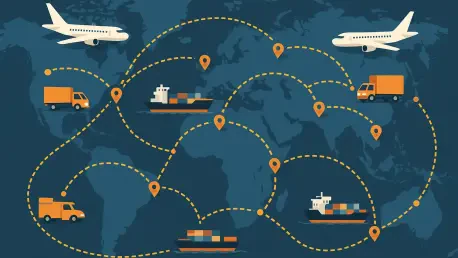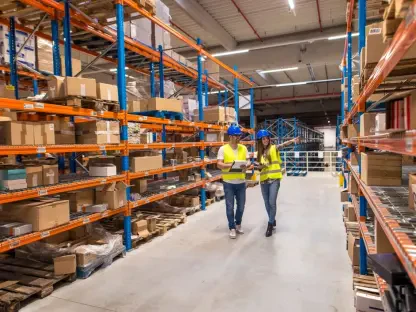Listen to the Article
Recently, global supply chains have faced more pressure due to several disruptive events that have changed international trade and logistics. Globalization has promoted connections between countries for many years, but increased geopolitical tensions now bring new risks and uncertainties that challenge business operations. Consequently, organizations worldwide must adjust to a challenging situation that requires advanced planning, flexibility, and solid logistics relationships. This article sheds further light on these issues.
What Risks On A World Scale Are Creating Problems For Supply Chains?
In the past, supply chains worked better when countries had stable relations. Now, too many hurdles are making global logistics, trade, and transportation more difficult. Here are some of the issues that the current supply chain is facing.:
1. Russia-Ukraine Conflict
The conflict between Ukraine and Russia has altered global trade and energy sector connections. Reducing energy purchases from Russia is causing energy prices in Europe to shift a lot. People are now looking for new energy sources and suppliers, which might also help to reduce carbon emissions. In the United States, the Inflation Reduction Act encourages investment in renewable energy, offering an excellent route to sustainability and helping society reduce the use of fossil fuels. Everything that makes energy cleaner also creates a greener and brighter future.
2. Anti-globalization Movement
Greater nationalism and stricter policies are changing international trade in goods and services. Thanks to anti-globalization moves and COVID-19 issues, some countries are now reconsidering their dependence on global markets. They are paying more attention to manufacturing goods locally. Using protectionism increases costs for companies and might influence their partnerships with overseas suppliers. Now, enterprises with a strong tie to international suppliers notice the need for flexible supply solutions to handle disruptions.
3. Cyber Attacks
Increasing threats in cybersecurity are making things more difficult. As organizations move their operations to digital frameworks, they start facing increased cyberattack threats. The cyberattack on Colonial Pipeline in the US proved how dangerous these risks to infrastructure can be. Cyberattacks have evolved beyond simple data breaches to include actions that disrupt business operations and logistics networks. Nowadays, they include actions that disrupt business activities and result in problems with finance and logistics. To avoid breakages in their supply chains, companies must enhance their cybersecurity and be mindful of political risks.
4. Tariffs And Other Impacts Of Economic Policies
Trade policy, such as tariffs, closely affects how companies manage their supply chains and select suppliers. The trade connection between the US and China partly affects product prices and sourcing options. Due to US tariffs on goods from China, many businesses have to change their suppliers or hike prices for buyers. For example, the Russia-Ukraine and Israel-Hamas battles have forced many regions to become less stable, which also contributes to problems in providing both energy and food. Consequently, inflation is taking place, which leads to supply chain costs going up for everything, including raw materials and transportation.
Therefore, several Asia-Pacific nations have teamed up to ensure they can access key resources such as important minerals for energy and industry. They hope to create trade ties with their partners to stabilize supplies and help them resist sudden disruptions.
A Case In Point: The Red Sea Crisis
Problems and insecurity in the Red Sea and Bab el Mandeb Strait disrupt vessels’ global use of a key shipping route. The link from the Indian Ocean to the Mediterranean Sea through the Suez Canal makes this route important for world commerce and oil movement. Recently, attacks from Houthi fighters have increased safety worries, blocked supply chains, and caused businesses that use shipping to pay more.
According to the International Maritime Organization, the Bab el Mandeb Strait is a key chokepoint through which about 4.5 million barrels of oil pass daily. However, the instability in the region has forced ships to take longer routes, resulting in higher fuel costs and longer shipping times. As the risk of attacks grows, many shipping companies are avoiding the Red Sea. This change affects logistics and causes delays at other ports.
Consequently, shipping costs have increased, and it now takes bigger ships more time to ship goods. For this reason, there is less capacity and growing demand, leading to Asia-Europe spot freight rates increasing by nearly five times. UNCTAD has stated that because of these problems, trade volumes have dropped by 42% in recent times, proving the significant effect of the Red Sea crisis on worldwide supply chains.
Solutions For Supply Chain Resilience
Because of major global issues, companies must adopt new strategies to stay strong in supply chain management. Here are four key strategies to consider:
1. Embrace Technology For Better Planning And Efficiency
Technology in supply chains allows companies to respond quickly to changes and make the system more secure. Although introducing digital methods usually involves a significant initial investment, they are often followed by good financial results. A 2023 survey by 451 Research found that over 30% of supply chain companies focus on digital transformation to increase revenue and cut costs.
Using advanced analytics and artificial intelligence helps businesses improve their demand forecasting. Consequently, inventory management is more effective, and stockouts are rare. Efforts in digital areas related to fuel efficiency in the commercial transport sector may help lower transit costs and offer more budget for operations in difficult times. With better efficiency and extra cash, companies can deal with surprises in the supply chain more easily.
2. Diversify Your Supplier Base
Relying too much on one supplier can be risky, especially during tough economic or political times. Work with several suppliers for key materials or components to reduce this risk. Expanding your supplier network helps ensure you get a steady supply of materials, even if one supplier faces delays. This way of managing your supply chain lowers risks and allows your business to stay flexible, making it easier to adapt to changes in the global market.
3. Maintain Buffer Inventory And Capacity
Storing necessary goods in reserve is a clever approach to defending your business. This means your warehouse should be stocked with more than usual, and your factory should be ready to produce more goods. Thanks to the reserve, your company can meet any unexpected high demand or supply shortage without experiencing delays. Even though extra stock is expensive, it guarantees happy customers and reliable operations.
4. Develop Alternative Logistics Routes
Due to political problems, natural occurrences, and possible disturbances, the usual shipping routes may change, so companies must create backup plans for uninterrupted operations. Ensuring that products are delivered on time can be made easier by identifying other transportation routes with logistics companies and forming deals with carriers. Alternative transportation paths can be put in place so that transit delays from the Suez Canal are not a big concern during emergencies. With other logistics options, businesses can respond promptly and prevent interrupted circulation when the main routes are halted.
What Makes A Good Logistics Partner Important
Geopolitical tensions, trade policy shifts, cyber risks, and regional conflicts continue to profoundly reshape global logistics networks. As businesses navigate this volatile environment, resilience has become a strategic priority rather than a reactive measure. Success now depends on a company’s ability to anticipate risks, adapt operations swiftly, and maintain flexibility in the face of disruption.
Investing in technology, diversifying supplier networks, maintaining buffer inventories, and developing alternative logistics routes are no longer optional — they are essential components of modern supply chain management. Companies proactively embracing these approaches will be better positioned to withstand uncertainty, protect their supply lines, and meet customer expectations in an increasingly unpredictable global market.
Organizations can future-proof their logistics operations by focusing on agility, collaboration, and innovation, turning disruption into opportunity.









